View in other NatureServe Network Field Guides
NatureServe
Montana
Utah
Wyoming
Idaho
Wisconsin
British Columbia
South Carolina
Yukon
California
New York
Musk-root - Adoxa moschatellina
State Rank Reason (see State Rank above)
Sparsely distributed across southwest Montana. Populations are generally small, though they occur in habitats not generally impacted by human disturbance or invasive weeds. Building of roads and trails may potentially impact populations.
General Description
Musk-root is a small, delicate, musky-scented herbaceous perennial, 5-20 cm tall. The several basal leaves have long petioles and blades divided into threes 2-3 times, with the ultimate segments broadly egg-shaped and lobed. There is one opposite pair of smaller stem leaves which are less dissected. Usually 5 flowers are borne in a compact head-like inflorescence at the tip of the stem. The inconspicuous, yellowish-green flowers, 5-8 mm wide, are of two types: outside flowers usually have 3 sepals and 5 united petals, while the terminal flowers have 2 sepals and 4 united petals. The sepals are united to the wall of the ovary. The small dry fruit has 4-5 seeds.
Phenology
Flowering occurs in June and early July, and fruiting continues through July.
Diagnostic Characteristics
The leaves of this unusual plant resemble those of Aquilegia spp., and the flowers superficially resemble those of some Saxifraga spp., but it differs in having only 2-3 sepals. This monotypic family is most closely related to the Valerian Family from which it differs in having twice as many stamens as petals.
Species Range
Montana Range
Range Descriptions
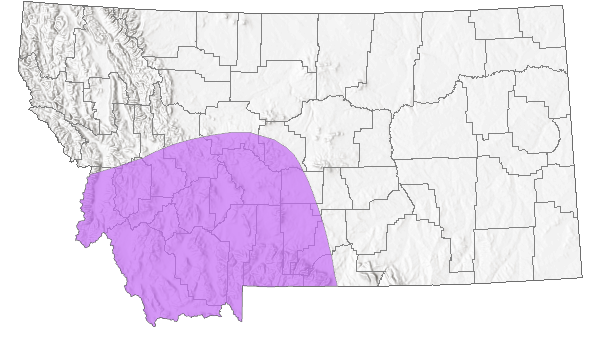
 Native
Native
Range Comments
A circumboreal plant of the upper Midwest and Canada extending south to southern Minnesota, Wisconsin, northern Illinois and northern Iowa. Disjunct populations in the Catskill Mountains of New York.
Observations in Montana Natural Heritage Program Database
Number of Observations: 53
(Click on the following maps and charts to see full sized version)
Map Help and Descriptions
Relative Density
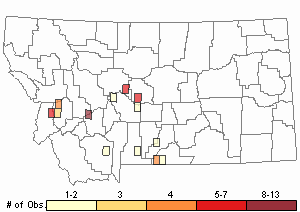
Recency
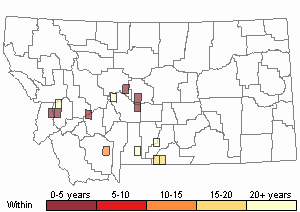
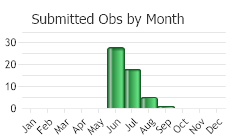
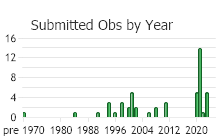
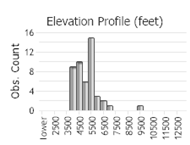 (Observations spanning multiple months or years are excluded from time charts)
(Observations spanning multiple months or years are excluded from time charts)
Habitat
Vernally moist places in the mountains at the bottom of undisturbed, open rock slides that have cold air drainage.
National Vegetation Classification System Groups Associated with this Species
Sparse and Barren
Sparse and Barren
Ecology
Populations are often small. Plants have been observed growing where cold air flow is channelled beneath rock slides.
Management
At one location where roads and trails were built across rock slides disrupting cold air flow from beneath the rocks, musk-root was not found in otherwise suitable habitat.
Stewardship Responsibility
Threats or Limiting Factors
STATE THREAT SCORE REASON
Reported threats to Montana’s populations of Musk-root are impacts due to livestock and potential impacts due to recreation and severe weather (MTNHP Threat Assessment 2021). Livestock grazing and trampling impacts a population where individuals are only found growing against rocks. One population is located at a campground where recreators may trample plants or populations. One population was partially destroyed following a flood. Information about the severity of impacts due to recreation or potential for severe weather to damage populations in the future is needed to assess the relative risk from these factors.
References
- Literature Cited AboveLegend:
 View Online Publication
View Online Publication MTNHP Threat Assessment. 2021. State Threat Score Assignment and Assessment of Reported Threats from 2006 to 2021 for State-listed Vascular Plants. Botany Program, Montana Natural Heritage Program, Helena, Montana.
MTNHP Threat Assessment. 2021. State Threat Score Assignment and Assessment of Reported Threats from 2006 to 2021 for State-listed Vascular Plants. Botany Program, Montana Natural Heritage Program, Helena, Montana.
- Additional ReferencesLegend:
 View Online Publication
View Online Publication
Do you know of a citation we're missing? Lesica, P., M.T. Lavin, and P.F. Stickney. 2012. Manual of Montana Vascular Plants. Fort Worth, TX: BRIT Press. viii + 771 p.
Lesica, P., M.T. Lavin, and P.F. Stickney. 2012. Manual of Montana Vascular Plants. Fort Worth, TX: BRIT Press. viii + 771 p. Lesica, P., M.T. Lavin, and P.F. Stickney. 2022. Manual of Montana Vascular Plants, Second Edition. Fort Worth, TX: BRIT Press. viii + 779 p.
Lesica, P., M.T. Lavin, and P.F. Stickney. 2022. Manual of Montana Vascular Plants, Second Edition. Fort Worth, TX: BRIT Press. viii + 779 p. Williams, K.L. 2012. Classification of the grasslands, shrublands, woodlands, forests and alpine vegetation associations of the Custer National Forest portion of the Beartooth Mountains in southcentral Montana. M.Sc. Thesis. Bozeman, MT: Montana State University. 376 p.
Williams, K.L. 2012. Classification of the grasslands, shrublands, woodlands, forests and alpine vegetation associations of the Custer National Forest portion of the Beartooth Mountains in southcentral Montana. M.Sc. Thesis. Bozeman, MT: Montana State University. 376 p.
- Web Search Engines for Articles on "Musk-root"





